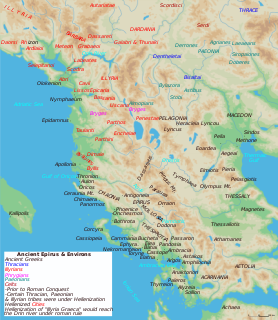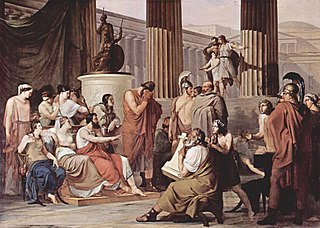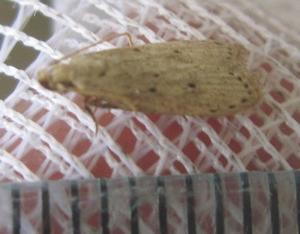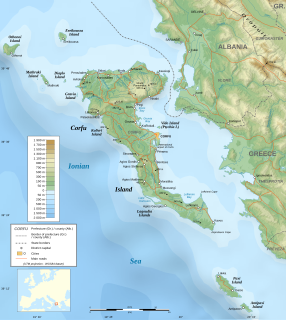Related Research Articles

Ambracia was a city of ancient Greece on the site of modern Arta. It was captured by the Corinthians in 625 BC and was situated about 11 km (7 mi) from the Ambracian Gulf, on a bend of the navigable river Arachthos, in the midst of a fertile wooded plain.
Pope Boniface III was the bishop of Rome from 19 February 607 to his death. Despite his short pontificate he made a significant contribution to the Catholic Church.
This article concerns the period 439 BC – 430 BC.
Year 435 BC was a year of the pre-Julian Roman calendar. At the time, it was known as the First year of the Consulship of Iullus and Tricostus. The denomination 435 BC for this year has been used since the early medieval period, when the Anno Domini calendar era became the prevalent method in Europe for naming years.
Year 433 BC was a year of the pre-Julian Roman calendar. At the time, it was known as the Year of the Tribunate of Vibulanus, Fidenas and Flaccinator. The denomination 433 BC for this year has been used since the early medieval period, when the Anno Domini calendar era became the prevalent method in Europe for naming years.
Asopus is the name of four different rivers in Greece and one in Turkey. In Greek mythology, it was also the name of the gods of those rivers. Zeus carried off Aegina, Asopus' daughter, and Sisyphus, who had witnessed the act, told Asopus that he could reveal the identity of the person who had abducted Aegina, but in return Asopus would have to provide a perennial fountain of water at Corinth, Sisyphus' city. Accordingly, Asopus produced a fountain at Corinth, and pursued Zeus, but had to retreat for fear of Zeus' terrible thunderbolt.

In Greek mythology, Alcinous was a son of Nausithous and brother of Rhexenor. After the latter's death, he married his brother's daughter Arete who bore him Nausicaa, Halius, Clytoneus and Laodamas. In some accounts, Alcinous' father was Phaeax, son of Poseidon and Corcyra, and brother of Locrus.

Periander, was the Second Tyrant of the Cypselid dynasty that ruled over Corinth. Periander's rule brought about a prosperous time in Corinth's history, as his administrative skill made Corinth one of the wealthiest city states in Greece. Several accounts state that Periander was a cruel and harsh ruler, but others claim that he was a fair and just king who worked to ensure that the distribution of wealth in Corinth was more or less even. He is often considered one of the Seven Sages of Greece, men of the 6th century BC who were renowned for centuries for their wisdom.
The Battle of Sybota took place in 433 BCE between Corcyra and Corinth, and was, according to Thucydides, the largest naval battle between Greek city states until that time. It was one of the immediate catalysts for the Peloponnesian War.
The Illyrian Wars were a series of wars fought between the Roman Republic and the Ardiaei kingdom. In the First Illyrian War, which lasted from 229 BC to 228 BC, Rome's concern was that the trade across the Adriatic Sea increased after the First Punic War at a time when Ardiaei power increased under queen Teuta. Attacks on trading vessels of Rome's Italic allies by Illyrian pirates and the death of a Roman envoy named Coruncanius on Teuta's orders, prompted the Roman senate to dispatch a Roman army under the command of the consuls Lucius Postumius Albinus and Gnaeus Fulvius Centumalus. Rome expelled Illyrian garrisons from a number of Greek cities including Epidamnus, Apollonia, Corcyra, Pharos and established a protectorate over these Greek towns. The Romans also set up Demetrius of Pharos as a power in Illyria to counterbalance the power of Teuta.
In Greek mythology, Harpina was a Naiad nymph and daughter of Phliasian Asopus and of Metope. Pausanias (5.22.6) and Diodorus Siculus (4.73.1) mention Harpina and state that, according to the tradition of the Eleans and Phliasians, Ares mated with her in the city of Pisa and she bore him Oenomaus, the king of Pisa. Oenomaus (6.21.8) founded and named after his mother the city of Harpina, not far from the river Harpinates, near Olympia. Pausanias (5.22.6) mentions Harpina in his description of a group sculpture, donated by the Phliasians, of the daughters of Asopus, which included Nemea, Zeus seizing Aegina, Harpina, Corcyra, Thebe and Asopus. The sculpture was located in the sanctuary of Hippodamia at Olympia.

Corinth was a city-state (polis) on the Isthmus of Corinth, the narrow stretch of land that joins the Peloponnese to the mainland of Greece, roughly halfway between Athens and Sparta. The modern city of Corinth is located approximately 5 kilometres (3.1 mi) northeast of the ancient ruins. Since 1896, systematic archaeological investigations of the Corinth Excavations by the American School of Classical Studies at Athens have revealed large parts of the ancient city, and recent excavations conducted by the Greek Ministry of Culture have brought to light important new facets of antiquity.
Lanassa was a daughter of king Agathocles of Syracuse, Sicily, perhaps by his second wife Alcia. In 295 BC Agathocles married Lanassa to King Pyrrhus of Epirus. Agathocles himself escorted his daughter with his fleet to Epirus to her groom. Lanassa brought the island of Corcyra as dowry into the marriage. The couple had two sons: Alexander and Helenus. However, Lanassa could not accept her husband's polygamous lifestyle, and so she left Pyrrhus in 291 BC, went to Corcyra, and offered this island as dowry to Demetrius I Poliorcetes, then king of Macedonia, if he would become her new husband. The courted diadoch came to Corcyra, married Lanassa and occupied the island. After the death of Agathocles Pyrrhus, as former husband of Lanassa, asserted hereditary claims to Sicily. On the basis of these claims the inhabitants of Syracuse asked Pyrrhus in 279 BC for assistance against Carthage.

The rice moth is a moth of the family Pyralidae. This small moth can become a significant pest. Its caterpillars feed on dry plantstuffs such as seeds, including cereals. Other recorded foods are flour and dried fruits.
Corfu is a major island in Greece.

Corcyra is a genus of snout moths. It was described by Ragonot in 1885, and is known from China, Great Britain, Australia, and Egypt.
The Siege of Issa took place from 230 BC to 229 BC between the forces of the Ancient Greek colony of Issa, aided by the Roman Republic, and the Ardiaean Kingdom of Illyria.
Two invasions of Epidamnus by Illyrian forces deployed by Queen Teuta attacking the Greek cities of Epirus took place as part of the Illyrian Wars in spring 229 BC.

The Battle of Paxos was a naval battle between a coalition of Illyrian federation with their Acarnanian allies, against the allies of Corcyra, the Achaean League and Aetolian League. The battle took place in the spring of 229 BC and was a direct consequence to the siege of Corcyra by the forces of queen Teuta.
Corcyra is Latin for Corfu, a Greek island in the Ionian Sea.
References
- 1 2 "GlobIZ search". Global Information System on Pyraloidea. Retrieved 2011-09-29.
| This Galleriinae-related article is a stub. You can help Wikipedia by expanding it. |